#american shipbuilding
Explore tagged Tumblr posts
Text
youtube
#youtube#ncl#carnival cruise#msc cruises#princess cruises#royal caribbean#carnival#kamala 2024#kamala harris#vote kamala#ss united states#ship preservation#maritime heritage#naval architecture#luxury liner#american maritime#ss united states history#united states lines#luxury travel#american shipbuilding#united states#transatlantic travel#engineering#united states line#ss america#famous oceanliners#american history#cruise ship#ocean liners#philadelphia
0 notes
Text

do you think anyone ever did yaois of these guys
#titanic#shipbuilding#m/m/m shipbuilding polycule#im in a too fancy restaurant#theyre playing a lounge cover of estelles american boy#just absolute nonsense sorry everyone
11 notes
·
View notes
Text
WIP Tag Game
Tagged by the lovely @enchi-elm, @jomiddlemarch, & @aloveforjaneausten. Thank you, kind friends!
RULES: Post the last sentence you wrote (fanfic / original / anything) and tag as many people as there are words in the sentence.
“Do you know,” she said, swallowing her wine, “I’d never heard of Donald McKay until I came to Collinsport?”
Tagging (oh my god i need to write shorter sentences i am so sorry): @boltlightning, @johnbly, @mercurygray, @shoshiwrites, @widowshill, @kazoobreakdown, @teamtadpole, @admiraleyk, @foolishpsychopomp, @itsalongwaytotipperary, @theonlyredcar, @starsuncounted, @r-osehips, @tockamybeloved, @homelesspersonchic, @evilbunnyking, @maggzblair, @intricatecaprice, @wendy-woodhouse, & you, denizen of blue heck dot com.
#me; writing a fic that has nothing to do with 19th century american shipbuilding: would you like to hear about clipper ships? TOO BAD.#... vicki babe ilu. but hand to god we are getting you some boat facts. you're my protagonist now and you need boat facts.#polkaknox talks#tag meme#my fic#... sorta
17 notes
·
View notes
Text

protectionism is back on the menu, boys.
#you love to see it#after decades of trade liberalism and the hollowing out of america's domestic industry#we're finally starting to see the government take some action to reverse course#i've been calling for this for years#good to see things are starting to finally move in that direction#from trump's tariffs and trade war with china to biden's chips act and the ukraine aid bills#and i'm regularly seeing news articles about the need to revitalize our shipbuilding industry#just a few weeks ago i saw that our secnav was in japanese shipyards#inviting investments/talent to come to american shipyards
4 notes
·
View notes
Text
Errors, “Errors,” and Sci Fi
@strawberry-crocodile
tvtropes calls stuff like the wolf example "science matches on" which I think is a pretty fair shake
This. This is what’s got me thinking so much about errors. There’s a certain danger, here. A certain way that this particular effect — delicious dramatic irony — tempts the mind when reading old stories, even true ones.
What do you know about R.M.S. Titanic? I ask my class every year, and the first hand rises. “It was unsinkable,” the student inevitably says, and everyone is nodding, “or so they thought.” I write the word UNSINKABLE on the board, underneath my crude drawing of a ship with four smokestacks. It will be crossed out before the end of the hour, but not for the reason they expect.
“I find no evidence,” Walter Lord, preeminent biographer of the ship’s survivors, wrote, “that Titanic was ever advertised as unsinkable. This detail seems to have entered the collective mind so as to create a more perfect irony.” Indeed, historians’ examinations of White Star Line documents show the shipbuilders themselves worried it would be so large as to risk collision; they stocked several more lifeboats than 1910s regulations required.
The War to End All Wars (deep breath, satisfied exhale), also known as World War ONE. Chuckle. Shake of the head. What if I told you that this phrase, used primarily in American newspapers after the fact, wasn’t meant to be literal? Nowadays we’d say The Mother of All Wars, or One Hell of a Fucking War, but we wouldn’t mean literal motherhood, literal intercourse. What if I said the armistice and the Lost Generation and the Roaring 20s were all braced for another outbreak of European conflict, and yet we still failed to prevent it?
Did you know they were so confident in the safety of the S.S. Challenger that they put a civilian schoolteacher onboard? I do, because I’ve heard that one repeated many times. Only, see, it’s got the cause and effect reversed. Challenger launched on a day the shuttle’s engineers knew to be dangerously cold, because the first civilian in space was on board. And NASA knew its shuttle project would be cancelled entirely, if they couldn’t get that civilian’s much-delayed entry into space in the next two weeks. So they launched on a cold day, and killed her instead.
These are all what cognitive science calls Hindsight Bias on the personal level, what sociology calls Presentism on the cultural level. Social psychology’s a little of both, is primarily interested in why you’re sitting on your couch in a Colonize Mars shirt watching PBS and chuckling at the fools who believed in El Dorado. It wants to know why the mind flees straight from “marijuana will kill you” to “marijuana will cure cancer” without so much as a pause on the middle ground of its real benefits and drawbacks, its real (mild) risks and rewards.
And they can paralyze the sci-fi writer, if you think too much about them. Jetsons is futurist one decade, retro the next. “There are no bathrooms on the Enterprise,” the creators of Serenity say smugly, as if Gene Roddenberry should’ve simply known that decades later it’d be acceptable to show a man peeing in full view of the camera, nothing but the curve of the actor’s hand to protect his modesty. “No sound in space,” the Fandom Menace says, “No explosions in space,” and “A space station can’t collapse in zero-G.” Only then NASA burns a paper napkin outside of atmosphere, transmits music using only the ghost of nearby planets’ gravities, and logs onto Reddit long enough to point out the Death Star would implode in its own gravity field. And now we’re the ones pointing, the ones laughing, at those earlier point-and-laughers. Self-satisfied, smug in superiority. As if we did the work to find out ourselves, instead of just happening to be born a little later than George Lucas.
#errors#continuity#sci fi#presentism#star wars#titanic#world war i#science marches on#history#started a new post because i got waaaaaay off topic here#if you think the dinosaurs in Jurassic Park (1993) should've had feathers#you're a lot more ignorant about paleontology than the people you're trying to criticize#science was not handed down to us in its perfect complete form circa 1943#stop for a second before you call out someone else's reptilian denonychus#someone else's oxygenated moon#and ask: am i better read#or am i just more recently born?
2K notes
·
View notes
Photo

Squanto (l. c. 1585-1622) was the Native American of the Patuxet tribe who helped the English settlers of Plymouth Colony (later known as pilgrims) survive in their new home by teaching them how to plant crops, fish, hunt, and generally acclimate to life in the so-called New World. He is also known as interpreter between the colonists and the Native Americans of the Wampanoag Confederacy led by the chief Ousamequin, better known by his title Sachem Massasoit (l. c. 1581-1661). Squanto's real name is believed to have been Tisquantum (as he is consistently called by colonist and chronicler Edward Winslow, l. 1595-1655) while “Squanto” is a nickname given him by the second governor of Plymouth Colony, and his close friend, William Bradford (l. 1590-1657). Squanto was kidnapped by the English captain Thomas Hunt in 1614 to be sold into slavery but either escaped or won his freedom in Spain and traveled to England where he learned English and worked as interpreter and shipbuilder. He returned to North America as interpreter on a trade mission and traveled with one Thomas Dermer back to his home village near present-day Cape Cod only to find his tribe had been wiped out by disease (probably smallpox) brought by European traders. In 1621, he was introduced to the settlers at Plymouth (who had founded their colony at the site of his old seasonal village) by the Abenaki chief Samoset (also known as Somerset, l.c. 1590-1653) who also spoke English. Squanto quickly became indispensable to the colonists and, recognizing his own power, he secretly worked to undermine the authority of Massasoit and empower himself. Once discovered, Massasoit demanded he be turned over for execution, but Bradford refused, a decision which endangered the treaty between the Wampanoag Confederacy and Plymouth Colony if Massasoit had insisted or tried to take Squanto by force. Squanto continued to serve as the colonists' guide and interpreter until 1622 when he died of fever or, as some historians have speculated, was executed by poison on orders from Massasoit. He is almost always depicted in history textbooks and children's books as “the friendly Indian” who saved the pilgrims and participated in the feast which has come to be known as the First Thanksgiving. These narratives ignore his plot against Massasoit or the circumstances surrounding how he came to learn English and, for the most part, he continues to be depicted as a one-dimensional character in the story of the pilgrims and the First Thanksgiving, although modern scholars and historians have made significant efforts to correct this image.
40 notes
·
View notes
Text







Donald McKay – Scientist of the Day
Donald McKay, a Canadian/American shipbuilder, died Sep. 20, 1880, at age 70.
read more...
#Donald McKay#shipbuilding#clipper ships#naval engineering#histsci#histSTM#19th century#history of science#Ashworth#Scientist of the Day
31 notes
·
View notes
Text
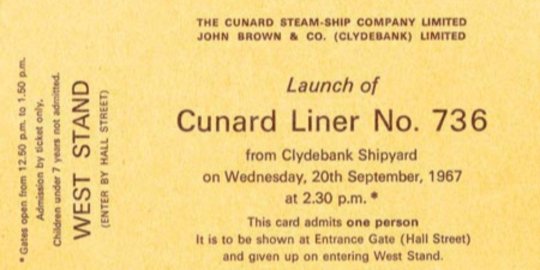

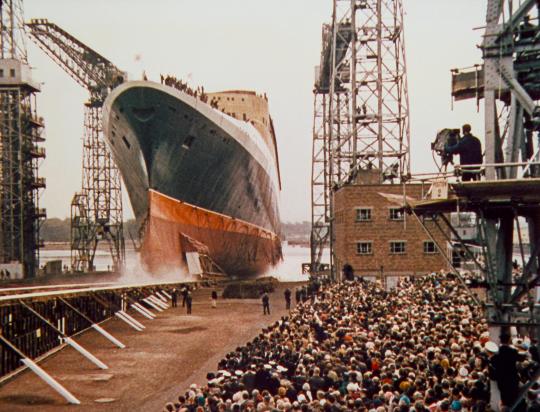
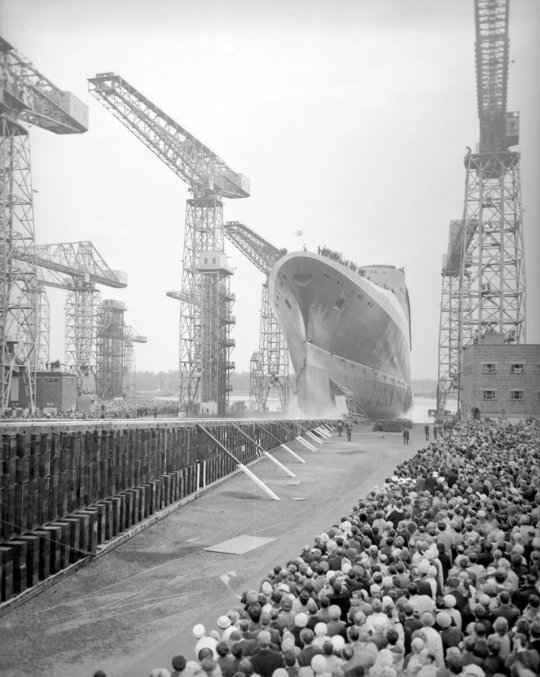
On 20th September, 1967, the QE2 launched from John Brown’s yard in Clydebank.
By the end of the 1950s, discussion over the replacement of the Queen Mary and Queen Elizabeth was taking place. The decision to replace the ‘Queens’ was deemed to be of national importance and as such a special committee, known as the Chandos Committee was created to advise the Government and to determine whether such a project was economically viable. Originally Cunard had wanted to build two new liners with the help of a Government subsidy, however the committee’s report proposed that the Government loan Cunard £18 million towards the construction of one vessel. The project became known as ‘Q3’ and six British shipyards were asked to tender – this prestigious project was a huge opportunity for home based shipbuilders to construct a transatlantic liner.
The new ship, code-named was built by John Brown & Company Ltd, Clydebank (later Upper Clyde Shipbuilders Ltd) and scheduled for May 1968. On 20th September 1967 the keel was launched by Queen Elizabeth II and the ship was named Queen Elizabeth 2. She was the last Atlantic Ocean Liner of it’s kind to be built in the UK.
QE2’s maiden transatlantic crossing set sail on 2 May 1969. She was well received by the American public, and became a profitable ship in her early years of service. During her first season, Cunard were able to repay £2.5 million of the Government loan. Her dual purpose design had allowed QE2 to thrive where her transatlantic counterparts could not.
In January 1971 while cruising in the Caribbean, QE2 received a distress call from the French liner Antilles. Antilles had run aground off the coast of Mustique in the Grenadines and caught fire. Being a fast ship in close proximity to the Antilles, QE2 went to her assistance.
However, by the time the QE2 arrived the passengers had been taken ashore. Antilles passengers and crew were brought aboard QE2 and taken to Barbados. As a testament to the quality of service offered aboard QE2, some of the Antille’s passengers booked subsequent cruises on the Cunarder.
In May 1972, while at sea during a transatlantic crossing, Captain William Law received notification that there was a bomb aboard QE2. Cunard took this threat very seriously and alerted the British Government who sent a bomb disposal unit out to the ship. Bomb disposal experts parachuted into the sea close to the ship and were brought aboard by QE2’s tenders. After a full sweep of the ship, the all clear was given as it turned out to be a hoax.
Later the FBI arrested the culprit for making similar threats against Pan American Airways. The bomb disposal teams were awarded the Queen’s Commendation for Brave Conduct.
As QE2’s cruising popularity increased and in response to the ongoing decline in shipping traffic on the North Atlantic, Cunard reduced the number of transatlantic crossings that QE2 took. The company maintained a strong summer presence on the Atlantic, however shifted the focus for the ship towards cruising. This saw QE2 undertake her first world cruise, an event that was well received – QE2 undertook a further 25 world cruises during her career.
Queen Elizabeth 2 was retired from active Cunard service in November 2008. She had been acquired by the private equity arm of Dubai World, which planned to begin conversion of the vessel to a 500-room floating hotel moored at the Palm Jumeirah, Dubai.
Following a multi-million-dollar investment programme, the 13-deck ship has been restored to her former glory and today serves as a world-class entertainment, tourism, hotel and dining destination in Dubai.
14 notes
·
View notes
Text
Vikings regularly visit North America 100s of years before that other guy stumbled upon the continent

Not only did Vikings travel to the Americas hundreds of years before Columbus (from 985 - 1450 CE), it also appears they made routine trips to extract natural resources there, including hemlock and jack pine - tree species not native to either Greenland or Europe.
A study published in the University of Iceland journal Antiquity argues that Norse colonists in Greenland relied on imported American timber for shipbuilding and large construction projects.
The study backs up Viking legends that say they had regular trading routes between Greenland and North America at least 500 years before other Europeans voyaged west.
source story: X
68 notes
·
View notes
Text
Diorama models made by Sailors
In addition to the well-known boneship models, ships in bottles, votive models and ornate ship models, seafarers also made dioramas with ships from the early 19th century onwards. Such models could vary in shape and quality depending on the material the sialor had access to. The hull could be made of solid mahogany or spruce. The rigging could be made of ribbons, rope or hair, and blocks of glass beads. The sails were usually made of wood or sheet metal.


Diorama of an American frigate from the time of the War of 1812. It is possible that this is the USS Chesapeake which lost her battle on 1 June 1813 against the HMS Shannon, 19th century (x)
Since not everyone had enough knowledge of shipbuilding, the models could not look real in their proportions, mast and number of sails (something we already know from the boneships). As soon as the model was finished, it was mounted in a box with a background and waterline and the box was surrounded with a picture frame so that it could be hung on the wall.

Mahagony Diorama, mid - late 19th century (x)

Danish half-model ship, diorama of a three-masted full-rigged ship, 19th century (x)
Due to the often not so high quality materials and the weather conditions at sea, many of the early models are no longer available today and even those from the mid and late 19th century are often very badly damaged. And yet they are a testament to the great craftsmanship of the sailors of the time. They were often used as souvenirs, but could also be made to order and then sold.
167 notes
·
View notes
Text
Satellite images spy Iranian 'mothership' linked to mysterious drones flying over New Jersey
Satellite images have spotted the Iranian 'mothership' linked to the mysterious drones in New Jersey.
The Shahid Bagheri drone carrier was last seen at its berth in the Iran Shipbuilding & Offshore Industries Complex on November 12, but an image taken 18 days later showed its docking station empty.
That is around the same time New Jersey police started to be inundated with sightings of drones in the skies, flying in clusters and acting strangely.
New Jersey Republican Rep Jeff Van Drew claimed this week there was 'circumstantial evidence’ that Iran's ship was releasing the drones from America's East Coast.
Van Drew said that Iran made a deal with China 'to purchase drones, a mothership and other technologies' for the drone attack on the US, a theory the Pentagon has dismissed.

Drew doubled down on his claims Thursday, saying 'credible individuals that have security clearance... believe there's a real possibility it could be Iran.'
He also argued that the US is not being told the truth and the American public are being treated as 'stupid.'
The 800ft-long Shahid Bagheri has since been spotted on satellite in the open waters of the Persian Gulf. It would take around 13 days for the ship to travel from Iran to America's East Coast.

9 notes
·
View notes
Text
Oil Interests Gave More Than $75 Million to Trump PACs, New Analysis Shows. (New York Times)
Oil and gas interests have given an estimated $75 million to Donald J. Trump’s presidential campaign, the Republican National Committee and affiliated committees, far more than has been previously known, according to a new analysis of federal campaign data.
The billionaires Harold Hamm of Continental Resources, Kelcy Warren of Energy Transfer Partners and Jeffery Hildebrand of Hilcorp Energy Co. are among the highest-profile oil and gas contributors to Mr. Trump, giving along with their spouses and companies more than $15 million this cycle.
But the total amount of money flowing to Mr. Trump and his allies from donors with links to fossil fuels is more than five times greater, according to an analysis by the environmental group Climate Power. It comes from mine operators, shipbuilders, engineering firms, hedge funds and little-known oil producers.
That is just the campaign cash that can be found in public records; donations made to nonprofits such as 501(c)(4) organizations, also known as dark money, are usually not publicly disclosed.
“It’s important to start by looking at this systematically and structurally,” said Senator Sheldon Whitehouse, Democrat of Rhode Island and chairman of the Senate Budget Committee, who is investigating oil industry campaign donations.
Mr. Whitehouse referred to an analysis by the International Monetary Fund that found American fossil fuel companies receive $700 billion of subsidies each year, when accounting for federal tax breaks and undercharging of environmental costs. He was not surprised by the contributions from oil interests to Mr. Trump.
“To protect a $700 billion subsidy, what is the amount that would be economically reasonable to spend in its defense?” Mr. Whitehouse asked.
Mr. Trump’s campaign did not respond to requests for comment.
He has promised the oil and gas industry unfettered access to drilling on public lands and in federal waters, reducing his energy platform to “DRILL, BABY, DRILL.”
At an April 11 dinner with oil executives at Mar-a-Lago, Mr. Trump’s private club in Florida, he asked them to donate $1 billion to his campaign, saying they would save far more than that in avoided taxes and legal fees after he repealed environmental regulations, according to several attendees who requested anonymity to discuss a private event.
8 notes
·
View notes
Text
15 Inventors Who Were Killed By Their Own Inventions
Marie Curie - Marie Curie, popularly known as Madame Curie, invented the process to isolate radium after co-discovering the radioactive elements radium and polonium. She died of aplastic anemia as a result of prolonged exposure to ionizing radiation emanating from her research materials. The dangers of radiation were not well understood at the time.
William Nelson - a General Electric employee, invented a new way to motorize bicycles. He then fell off his prototype bike during a test run and died.
William Bullock - he invented the web rotary printing press. Several years after its invention, his foot was crushed during the installation of the new machine in Philadelphia. The crushed foot developed gangrene and Bullock died during the amputation.
Horace Lawson Hunley - he was a marine engineer and was the inventor of the first war submarine. During a routine test, Hunley, along with a 7-member crew, sunk to death in a previously damaged submarine H. L. Hunley (named after Hunley’s death) on October 15, 1963.
Francis Edgar Stanley - Francis crashed into a woodpile while driving a Stanley Steamer. It was a steam engine-based car developed by Stanley Motor Carriage Company, founded by Francis E. Stanley and his twin Freelan O. Stanley.
Thomas Andrews - he was an Irish businessman and shipbuilder. As the naval architect in charge of the plans for the ocean liner RMS Titanic, he was travelling on board that vessel during her maiden voyage when the ship hit an iceberg on 14 April 1912. He perished along with more than 1,500 others. His body was never recovered.
Thomas Midgley Jr. - he was an American engineer and chemist who contracted polio at age 51, leaving him severely disabled. He devised an elaborate system of ropes and pulleys to help others lift him from the bed. He was accidentally entangled in the ropes of the device and died of strangulation at the age of 55.
Alexander Bogdanov - he was a Russian physician and philosopher who was one of the first people to experiment with blood transfusion. He died when he used the blood of malaria and TB victim on himself.
Michael Dacre - died after testing his flying taxi device designed to permit fast, affordable travel between regional cities.
Max Valier - invented liquid-fuelled rocket engines as a member of the 1920s German rocket society. On May 17, 1930, an alcohol-fuelled engine exploded on his test bench in Berlin that killed him instantly.
Mike Hughes - was killed when the parachute failed to deploy during a crash landing while piloting his homemade steam-powered rocket.
Harry K. Daghlian Jr. and Louis Slotin - The two physicists were running experiments on plutonium for The Manhattan Project, and both died due to lethal doses of radiation a year apart (1945 and 1946, respectively).
Karel Soucek - The professional stuntman developed a shock-absorbent barrel in which he would go over the Niagara Falls. He did so successfully, but when performing a similar stunt in the Astrodome, the barrel was released too early and Soucek plummeted 180 feet, hitting the rim of the water tank designed to cushion the blow.
Hammad al-Jawhari - he was a prominent scholar in early 11th century Iraq and he was also sort of an inventor, who was particularly obsessed with flight. He strapped on a pair of wooden wings with feathers stuck on them and tried to impress the local Imam. He jumped off from the roof of a mosque and consequently died.
Jean-Francoise Pilatre de Rozier - Rozier was a French teacher who taught chemistry and physics. He was also a pioneer of aviation, having made the first manned free balloon flight in 1783. He died when his balloon crashed near Wimereux in the Pas-de-Calais during an attempt to fly across the English Channel. Pilâtre de Rozier was the first known fatalities in an air crash when his Roziere balloon crashed on June 15, 1785.
50 notes
·
View notes
Text
Pérez embodied many aspects of the immigration debate. He had exactly the skills that American companies are desperate for. He was an expert welder, willing to work in the cramped, dangerous spaces inside ships. And Pérez was able to earn $23 an hour at a shipyard in Houma, many times more than he could in his home country. Slightly built with jet-black hair, Pérez was funny, diligent and eager to succeed. He had begun building a life in the U.S.
But, like millions of others, Perez had not been able to do that legally. This spring, the secretary of Navy, Carlos del Toro, called for creating exactly such a pathway, to help construct the ships the Navy needs. “What we’ve got to do is open up the spigot a bit,” he said. “Allow blue-collar workers to come here.”
Without a work permit, Pérez was vulnerable. He worked at the shipyard but not for it, a contractor for a subcontractor.
Pérez’s story is emblematic of a system that relies ever more on immigrants, even as employers and politicians vilify the very people doing work that generates profits and serves the nation. Employers use subcontractors and independent contractors to pass the risks and costs on to the workers, said Laura Padin, director of work structures at the National Employment Law Project. “These companies, particularly in occupations and industries with high rates of health and safety violations, use this to shield themselves from responsibility,” she said. “We also see that they do this with workers who are immigrants if they think they’re undocumented so that they can avoid responsibility for hiring someone who’s undocumented.” The point, Padin said, is to “protect the entity at the top.”
4 notes
·
View notes
Note
What will it take to save the United States?
nurture her, then unleash her. like our founding fathers did. we have neglected her.
not sure how specific/deep you want me to get but i'll give you some ideas: we need to reshore manufacturing (specifically high-tech manufacturing. china can keep making plastic children's toys and shit (actually we should near-shore that shit to latin america) but robotics, batteries, automobiles, drones, shipbuilding, etc, need to be built in america). do this with a combination of tariffs and subsidies.
we need civil service reform. i love bureaucracy. i love the civil service. but it's become bloated and stagnant and too unruly. it needs to be reformed, purged, and revitalized.
secure the border and reform immigration to close asylum loopholes.
tax reform. reduce or abolish income tax. add vat and lvt. basic income or negative income tax or something along those lines.
streamline regulation. i love the state. and i love state intervention. but again, regulations have become unwieldy and outdated. keep the necessary shit, get rid of the bloat.
establish my dream agency -- OPUS. cultivate and preserve american culture and way of life. foster a new american renaissance. a new great awakening. a new wave of national identity and patriotism and unification. sounds nebulous but i believe there are concrete steps to this end.
reform education. again, not sure how in depth you want to get. but i think it's overdue.
i could keep going but i gotta start dinner.
2 notes
·
View notes
Text
Some more obscure facts about Lewis Nixon the shipbuilder and politics in 1920s
The other day, I found this piece in old newspapers that Lew’s grandmother was sitting in the box of the governor of New York Alfred E. Smith with Mrs Franklin D. Roosevelt in a Democratic convention compaigning for the election of governor of New York. I thought this was strange. I knew that Lew’s grandfather was briefly the leader of Tammany Hall, but very briefly, since he was tasked with the mission of cleaning up the corrupt Tammany Hall and failed miserably.

Alfred E. Smith was probably one of the most competent governor of New York in history, and he stayed in office for nearly the entire 1920s. His political legacy included eight-hour day for women and children, minimum wages, to grant state pensions to widows with children so they don’t have to be sent to orphanage if the mother can’t find a job to support the family. (Alfred Smith himself was a child of a widow and he was dropped out of school at age 14 to work at a fish market)
It turns out that Lew’s grandfather was a long-time friend with Alfred E. Smith. They were allies since 1918. When Lewis Nixon died in 1940, Alfred E. Smith was his pallbearer.

Franklin D. Roosevelt was a protege of Alfred E. Smith. He started compaigning for Smith since 1918 NY governor election, and worked for Smith’s every elections since then. However they turned against each other in fighting for the nomination of 1932 presidential election. Lewis Nixon the shipbuilder backed Alfred E. Smith everytime, and even supported him to run againt FDR in the 1936 presidential election.
1918, FDR first spoke for Alfred E. Smith (in the same news, Lew’s grandmother accepted the chairmanship of the Alfred E. Smith's Women's Campaign Committee of Greater New York. In the state of New York, women had the right to vote since 1918). In this election, Alfred E. Smith beat the incumbent governor Charles S. Whitman.
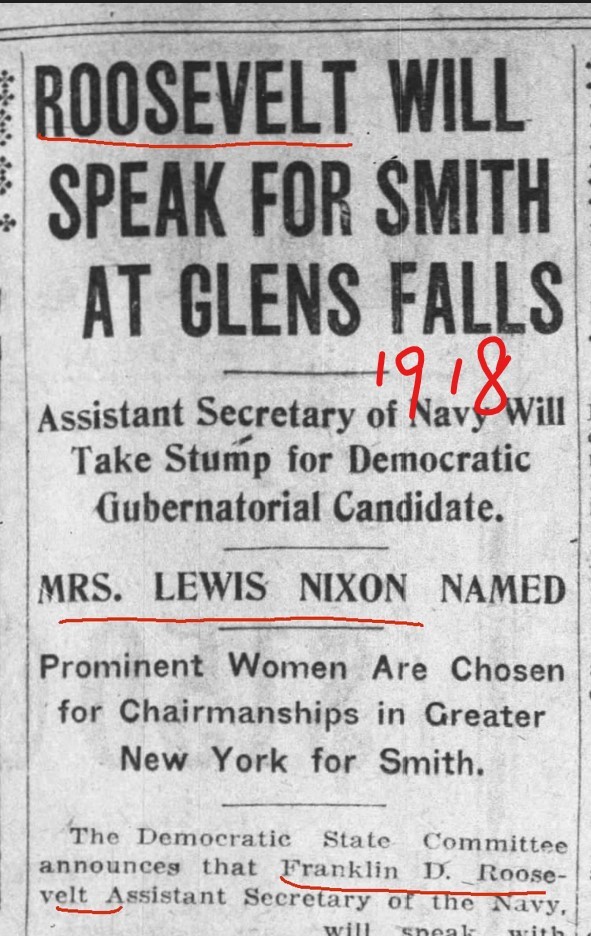
Actually, the incumbent governor Charles S. Whitman was the one who gave Doris away at her wedding with Stanhope in 1917.

In 1919, Lew’s grandfather was appointed by Alfred Smith as the superintendent of public works.

Shown below are a collection of newspaper clippings of Lewis Nixon throwing dinner parties for Alfred Smith:
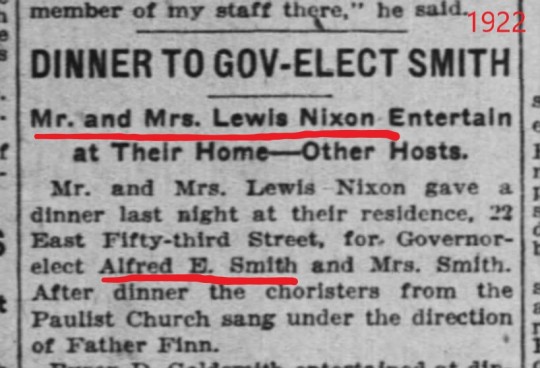



By the way, in 1926 seven-yr old Lew participated in a model yacht competition. Grandpa browbeat him to name his boat “Mayor Walker”. That’s Jimmy Walker, another protege of Alfred E. Smith.

In 1928, Lewis Nixon, Franklin D. Roosevelt and Jimmy Walker were all invited to the wedding of Alfred Smith’s daughter Katherine.
Therefore, I believe lil Lew did indeed know FDR, because FDR was not only a close colleague of his grandfather’s besty, but also a immediate neighbor, for the Roosevelts lived at the opposite door to the Nixons on East 65th St.

FDR lived here and worked from here. This townhouse served as the compaign headquarter of Alfred E. Smith because FDR can’t walk to the actual headquarter on madison street.
Lew’s grandmother was still socializing with Eleanor Roosevelt in 1930 at least.

However, the Nixons sided with Alfred E. Smith when he and FDR fought for the Democratic nomination for the 1932 presidential election. FDR won.

Lew’s grandfather was still promoting Alfred Smith in the 1936 election, but Smith didn’t run this time.
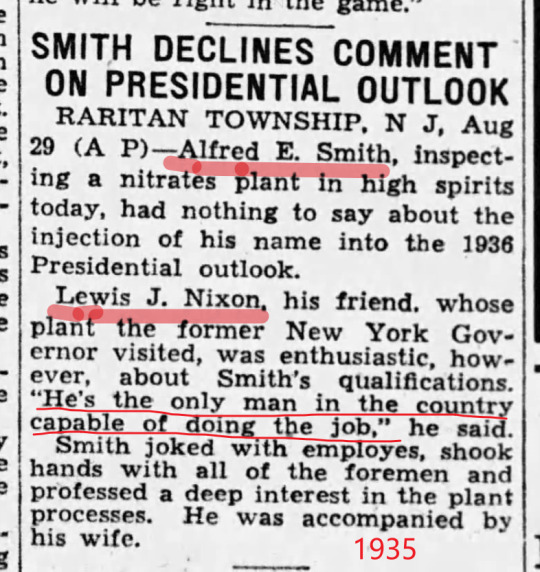
Smith vehemently critisized FDR’s new deal. However, he was one of the first American politicians who publicly warned against the evil of Hitler and Nazis in early 1933 (mind you, in 1933, Hitler was still a fasionable strong man in public view)
Smith came to Roosevelt’s defense as the president sought to amend the country’s neutrality laws (i.e. to sell arms to Britain and France after they declared war on Germany).
Alfred Smith said Roosevelt was “is so obviously right, so obviously on the side of common sense”.
In 1944, when both men had only months to live, an acquaintance asked Smith what he thought of Roosevelt, who was running for a fourth term as president of the United States, Smith said “he was the kindest man who ever lived, but don’t even get in his way”.
#band of brothers#Alfred E. Smith#franklin d roosevelt#Obscure facts about Lewis Nixon#lewis nixon#shipbuilder
22 notes
·
View notes